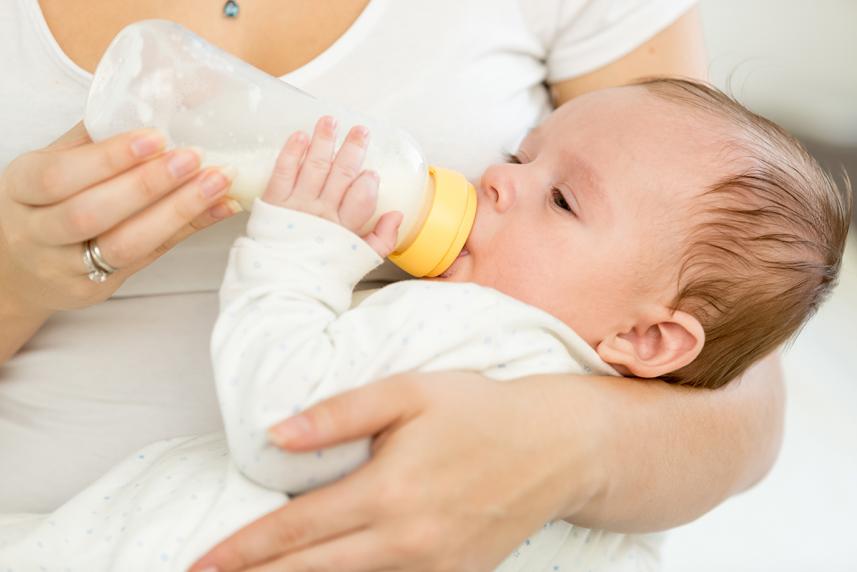Bottle-feeding: FAQs, answered
Here’s everything expecting mothers should know about bottle-feeding a new baby

Your little bundle of joy is getting bigger each day from within your uterus. And once they arrive, expect that growth to continue tenfold. That’s, in part, because they’ll be eating all the time—every two to three hours, to be exact.
Of course, knowing the ins and outs of feeding your baby won’t happen intuitively. And especially when it comes to bottle-feeding, you’ll need to do a bit of prep work before your bundle of joy arrives to ensure things go smoothly.
- What should I be feeding my baby?
For at least the first few months of life, your baby will be on an exclusively liquid diet of either breast milk or formula.
The American Academy of Pediatrics (AAP) recommends exclusive breastfeeding for babies age six months and under, but if you aren’t breastfeeding, you may still be able to feed your baby breast milk. This requires a manual or electric hand pump.
“There are some really great benefits to breast milk, regardless of how a baby gets it,” says Rebecca Dudovitz, M.D., an assistant professor in general pediatrics and vice-chair of the Primary Care College in the David Geffen School of Medicine at UCLA. “For example, breast milk has antibodies and other factors that help protect infants from illnesses.” Babies who are breastfed have a lower risk of respiratory diseases and ear infections, and are less likely to develop obesity and asthma, according to the Centers for Disease Control and Prevention.
- Is formula okay to use instead?
Another option is to feed your baby formula, which contains protein, fat, and sugar, plus other nutrients, including iron. While some women choose not to breastfeed, others may be unable to. The good news is that, if you choose to solely use formula, your baby is getting a great source of nutrition. “From a health standpoint, all formulas are nutritionally equivalent,” Dr. Dudovitz says, noting that most formula on the market contains cow milk (which has been altered to make it more easily digestible for infants).
Formula generally comes in three forms: powder, liquid concentrate, and ready-to-feed.
- What type of bottle is best?
While there’s no one bottle that’s right for all babies, your best bet is to buy a few different types to see which variety your little one prefers.
Some popular options include standard bottles, with straight edges; angled bottles, which can help prevent your baby from sucking in air; vented bottles, which can help prevent air bubbles from building up in the bottle, thereby possibly reducing colic; and wide neck bottles, which are designed to be more like a mother’s breast.
- How much should babies eat?
On average, babies should eat about two-and-a-half ounces of formula each day for every one pound of body weight. (For example, a 10-pound baby will eat about 25 ounces of formula each day.)
By the time your baby is a month old, they’ll be eating about two to three ounces every three to four hours, and by the time they’re six months, they’ll be eating six to eight ounces at a time, usually four or five times a day, according to the AAP.
Still, those are just general guidelines. “Just like us, babies are unique and have different appetites on different days,” she says. “There can be a lot of variation from one baby to the next, and one feeding to the next.”
The most important thing parents can do when feeding their babies is to follow their child’s cues. “Look for signs of hunger, like lip smacking, tongue thrusting, and vigorous sucking,” she says. Also be sure to consult with your doctor if you’re unsure––especially if your baby was premature or has a medical condition.
- How do I know when my baby is full?
“Newborns have a sucking reflex,” says Dr. Dudovitz, “so they’ll suck on a bottle if you put it in their mouth, even if they are not hungry.”
Try taking the bottle out of your baby’s mouth every half ounce or so and waiting a few seconds to put it back in. That way, babies “have more time to process whether they are full or not,” she says. “A good general rule is to try and make the feeding last at least 10 to 15 minutes.”
Look, too, for signs that your little one is satisfied. Babies who are full usually won’t suck as vigorously on the bottle, will grow sleepy or more relaxed, and won’t protest very much when you take away the bottle, she says.
- What should I do if I’m having trouble breastfeeding?
If you’re struggling with breastfeeding, you’re not alone. “Lots of women struggle with breastfeeding,” she says, adding, “the first few weeks can be really tough.”
In fact, about 60 percent of mothers don’t breastfeed for as long as they’d hoped, in part because they had difficulties lactating or were concerned with their baby’s weight, according to a study published in the journal Pediatrics.
“The key to managing breastfeeding difficulties is to get help early and often,” says Dr. Dudovitz, adding that a lactation consultant can help.
Keep in mind, too, that some babies—such as those who aren’t gaining enough weight or need to be hospitalized for jaundice—may need to be bottle-fed either pumped breastmilk or formula, she says.
Plus, “a mom’s mental health is super important to both her health and her baby’s,” she says. “If breastfeeding is interfering with a mom’s mental health, that may be another reason to choose a different feeding practice.”
Talk it over with your baby’s pediatrician to find the right answer for you and your little one.



